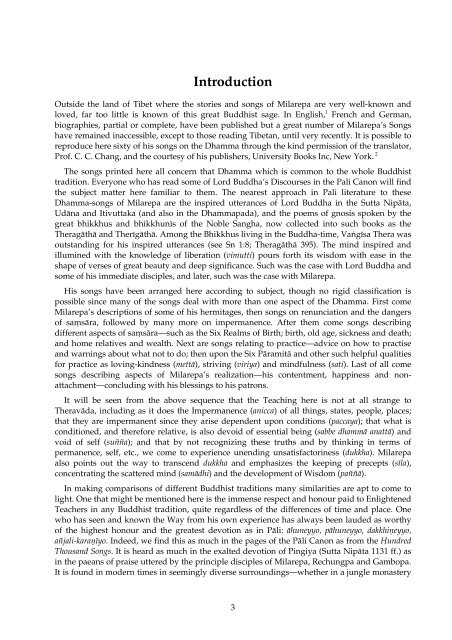Sixty Songs of Milarepa - Buddhist Publication Society
Sixty Songs of Milarepa - Buddhist Publication Society
Sixty Songs of Milarepa - Buddhist Publication Society
You also want an ePaper? Increase the reach of your titles
YUMPU automatically turns print PDFs into web optimized ePapers that Google loves.
Introduction<br />
Outside the land <strong>of</strong> Tibet where the stories and songs <strong>of</strong> <strong>Milarepa</strong> are very well-known and<br />
loved, far too little is known <strong>of</strong> this great <strong>Buddhist</strong> sage. In English, 1 French and German,<br />
biographies, partial or complete, have been published but a great number <strong>of</strong> <strong>Milarepa</strong>’s <strong>Songs</strong><br />
have remained inaccessible, except to those reading Tibetan, until very recently. It is possible to<br />
reproduce here sixty <strong>of</strong> his songs on the Dhamma through the kind permission <strong>of</strong> the translator,<br />
Pr<strong>of</strong>. C. C. Chang, and the courtesy <strong>of</strong> his publishers, University Books Inc, New York. 2<br />
The songs printed here all concern that Dhamma which is common to the whole <strong>Buddhist</strong><br />
tradition. Everyone who has read some <strong>of</strong> Lord Buddha’s Discourses in the Pali Canon will find<br />
the subject matter here familiar to them. The nearest approach in Pali literature to these<br />
Dhamma-songs <strong>of</strong> <strong>Milarepa</strong> are the inspired utterances <strong>of</strong> Lord Buddha in the Sutta Nipāta,<br />
Udāna and Itivuttaka (and also in the Dhammapada), and the poems <strong>of</strong> gnosis spoken by the<br />
great bhikkhus and bhikkhunīs <strong>of</strong> the Noble Sangha, now collected into such books as the<br />
Theragāthā and Therīgāthā. Among the Bhikkhus living in the Buddha-time, Vagīsa Thera was<br />
outstanding for his inspired utterances (see Sn 1:8; Theragāthā 395). The mind inspired and<br />
illumined with the knowledge <strong>of</strong> liberation (vimutti) pours forth its wisdom with ease in the<br />
shape <strong>of</strong> verses <strong>of</strong> great beauty and deep significance. Such was the case with Lord Buddha and<br />
some <strong>of</strong> his immediate disciples, and later, such was the case with <strong>Milarepa</strong>.<br />
His songs have been arranged here according to subject, though no rigid classification is<br />
possible since many <strong>of</strong> the songs deal with more than one aspect <strong>of</strong> the Dhamma. First come<br />
<strong>Milarepa</strong>’s descriptions <strong>of</strong> some <strong>of</strong> his hermitages, then songs on renunciation and the dangers<br />
<strong>of</strong> sasāra, followed by many more on impermanence. After them come songs describing<br />
different aspects <strong>of</strong> sasāra—such as the Six Realms <strong>of</strong> Birth; birth, old age, sickness and death;<br />
and home relatives and wealth. Next are songs relating to practice—advice on how to practise<br />
and warnings about what not to do; then upon the Six Pāramitā and other such helpful qualities<br />
for practice as loving-kindness (mettā), striving (viriya) and mindfulness (sati). Last <strong>of</strong> all come<br />
songs describing aspects <strong>of</strong> <strong>Milarepa</strong>’s realization—his contentment, happiness and nonattachment—concluding<br />
with his blessings to his patrons.<br />
It will be seen from the above sequence that the Teaching here is not at all strange to<br />
Theravāda, including as it does the Impermanence (anicca) <strong>of</strong> all things, states, people, places;<br />
that they are impermanent since they arise dependent upon conditions (paccaya); that what is<br />
conditioned, and therefore relative, is also devoid <strong>of</strong> essential being (sabbe dhammā anattā) and<br />
void <strong>of</strong> self (suñña); and that by not recognizing these truths and by thinking in terms <strong>of</strong><br />
permanence, self, etc., we come to experience unending unsatisfactoriness (dukkha). <strong>Milarepa</strong><br />
also points out the way to transcend dukkha and emphasizes the keeping <strong>of</strong> precepts (sīla),<br />
concentrating the scattered mind (samādhi) and the development <strong>of</strong> Wisdom (paññā).<br />
In making comparisons <strong>of</strong> different <strong>Buddhist</strong> traditions many similarities are apt to come to<br />
light. One that might be mentioned here is the immense respect and honour paid to Enlightened<br />
Teachers in any <strong>Buddhist</strong> tradition, quite regardless <strong>of</strong> the differences <strong>of</strong> time and place. One<br />
who has seen and known the Way from his own experience has always been lauded as worthy<br />
<strong>of</strong> the highest honour and the greatest devotion as in Pāli: āhuneyyo, pāhuneyyo, dakkhieyyo,<br />
añjali-karaīyo. Indeed, we find this as much in the pages <strong>of</strong> the Pāli Canon as from the Hundred<br />
Thousand <strong>Songs</strong>. It is heard as much in the exalted devotion <strong>of</strong> Pingiya (Sutta Nipāta 1131 ff.) as<br />
in the paeans <strong>of</strong> praise uttered by the principle disciples <strong>of</strong> <strong>Milarepa</strong>, Rechungpa and Gambopa.<br />
It is found in modern times in seemingly diverse surroundings—whether in a jungle monastery<br />
3
















